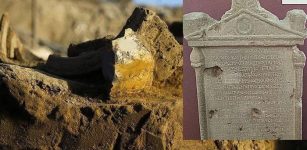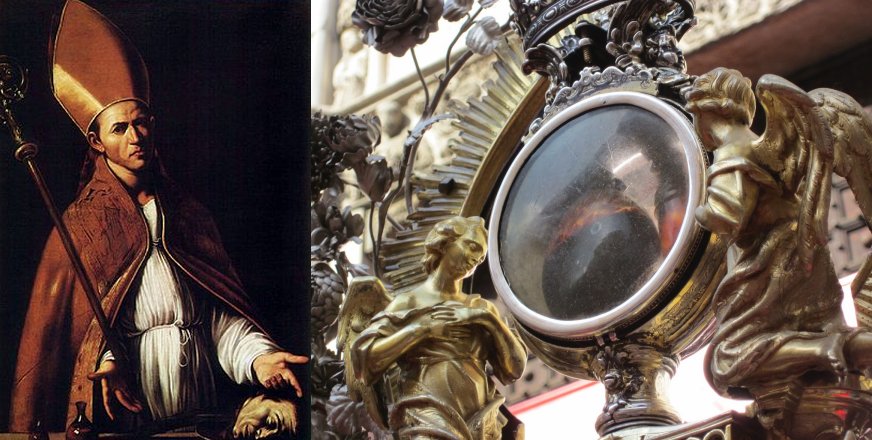Blood Of St. Januarius – One Of The Most Remarkable Christian Relics
Ellen Lloyd - Ancient Pages.com - One of the most remarkable Christian relics is a sealed glass ampoule that contains the blood of St. Januarius.
It’s a sacred Christian object that often causes a lot of attention. For some unknown reason, the black mass sometimes fails to liquefy and this is regarded as a bad omen. It is said that when the blood fails to liquefy, something tragic will happen to the city of Naples that year.
Who Was St. Januarius?
St. Januarius is venerated figure among the Neopolitans, and the annual celebration and viewing of the miracle is a highly significant and prophetic event.
On June 13, 313 AD, Edict of Milan was signed by Roman Emperor Constantine and the persecution of Christians ended. St. Januarius was not fortunate enough to experience that day. He was killed about 305 B.C., during the Diocletianic Persecution that was the last and most severe persecution of Christians in the Roman Empire.
Bon in Italy during the 3rd century, St. Januarius was declared a martyr and saint of the Roman Catholic and the Eastern Orthodox Churches. We possess very little information about his life, but we know he was bishop of Benevento during the Emperor Diocletion persecution.
Martyrdom of Saint Januarius by Girolamo Pesce - Bishop's Library, Vác, Hungary.
According to legend, Januarius became a priest when he was only 15 years. These were dangerous times for Christians. Living in a pagan society many believers feared for their lives. When Januarius was 20 he became bishop and during the 1 1⁄2-year-long persecution of Christians by Emperor Diocletian, bishop Januarius and his Christian followers managed to avoid being caught. ‘
However, while visiting two deacons and two laymen in prison, bishop Januarius was arrested and sentenced to death. There are two versions of how he died. According to some stories, bishop Januarius and his colleagues were condemned to be thrown to wild bears in the Flavian Amphitheater at Pozzuoli.
See also:
Biblical Mystery Of Urim And Thummim: God’s Puzzling Communication Devices
Mesha Stele: One Of The Most Valuable Biblical Artifacts
Lost Q Source Remains An Unsolved Biblical Mystery
Due to fear of public disturbances, the sentenced was changed and they were instead beheaded at the Solfatara crater near Pozzuoli. One legend tells, these Christian men were thrown to the wild beasts, but when the animals did not attack them, they were beheaded instead.
Today, the feast of St. Januarius is held on September 19 and he is patron of blood banks. Although the city of Naples has more than fifty official patron saints, its principal patron is Saint Januarius.
Mystery Of The Ampoule Containing The Blood Of St. Januarius
The most remarkable part of St. Januarius’ history concerns his blood. According to an ancient legend, a woman by the name Eusebia saved his blood shortly after he died. His blood today is kept in a sealed glass ampoule in Naples Cathedral and traditionally liquefies three times a year: on September 19, December 16 and the Saturday before the first Sunday of May.
Thousands of people gather to witness the miracle because it is believed that the failure of the saint's blood to liquefy is associated with disastrous events.
Many people of Naples are concerned and remember the blood remaining solid a be a premonition of evil.
The same things happened in 1980, when an earthquake hit South Italy; 1973, when Naples endured an outbreak of cholera; 1939, when World War II began; 1940, when Italy joined the War and 1943, when Italy was occupied by the Nazis.
Blood of St. Januarius is kept in a sealed glass ampoule.
However, the blood is also said to spontaneously liquefy at certain other times, such as papal visits. Putting faith aside for a brief moment, we have right to wonder whether there is a scientific explanation as to why liquefaction sometimes takes place almost immediately and sometimes not at all.
This is the greatest problem because while the Catholic Church has always supported the celebrations, it has never formulated an official statement on the phenomenon and maintains a neutral stance about scientific investigations.
The blood of St Januarius is a sacred Christian relic that is kept in a vault and access and scientific studies are denied because of fear that examination of this sacred blood may cause irreparable damage.
On feast days, all relics, including St. Januarius’ blood are taken in procession from the cathedral to the Monastery of Santa Chiara, where the archbishop holds the reliquary up and tilts it to show that the contents are solid, and places it on the high altar next to the saint's other relics.
Even though a few early scientific studies were conducted, the results did not provide satisfactory explanation to the blood’s unusual behavior.
In more recent times, scientists have suggested that blood vial contains a thixotropic gel that changes in viscosity when someone moves or stirs it. Another theory is that the vials do not contain blood at all but hydrated iron oxide which resembles blood.
Currently, the blood of St. Januarius remains a mystery and scientists have yet to find a cause for the blood liquefying, but most researchers have ruled out the possibility the relic is a fraud.
Written by Ellen Lloyd – AncientPages.com
Copyright © AncientPages.com & Ellen Lloyd All rights reserved. This material may not be published, broadcast, rewritten or redistributed in whole or part without the express written permission of AncientPages.com and Ellen Lloyd
About the author:
Ellen Lloyd – is the owner of AncientPages.com and an author who has spent decades researching ancient mysteries, myths, legends and sacred texts, but she is also very interested in astronomy, astrobiology and science in general
More From Ancient Pages
-
 Bes: Egypt’s Intriguing Dwarf God Of Music, Warfare And Protector Against Snakes, Misfortune And Evil Spirits
Egyptian Mythology | Jul 31, 2016
Bes: Egypt’s Intriguing Dwarf God Of Music, Warfare And Protector Against Snakes, Misfortune And Evil Spirits
Egyptian Mythology | Jul 31, 2016 -
 Daily Life Of Télpochcalli Students Of The Aztec Empire Was A Challenge
Ancient History Facts | Apr 20, 2020
Daily Life Of Télpochcalli Students Of The Aztec Empire Was A Challenge
Ancient History Facts | Apr 20, 2020 -
 Mysterious Ancient Village In A Prehistoric Anomalous Zone – Dangerous Underground Secret – Part 2
Featured Stories | Jul 28, 2020
Mysterious Ancient Village In A Prehistoric Anomalous Zone – Dangerous Underground Secret – Part 2
Featured Stories | Jul 28, 2020 -
 Yali – Divine Protector And Guardian Of Temples Warding Off Evil Forces In Hindu Mythology
Featured Stories | Nov 7, 2020
Yali – Divine Protector And Guardian Of Temples Warding Off Evil Forces In Hindu Mythology
Featured Stories | Nov 7, 2020 -
 Your Destiny Is Engraved And Stored – Guardians Of The Great Mystery – Part 2
Featured Stories | Jul 11, 2018
Your Destiny Is Engraved And Stored – Guardians Of The Great Mystery – Part 2
Featured Stories | Jul 11, 2018 -
 On This Day In History: Tsar Peter The Great Opens New Chapter in Russia’s History – On Mar 19, 1697
News | Mar 19, 2017
On This Day In History: Tsar Peter The Great Opens New Chapter in Russia’s History – On Mar 19, 1697
News | Mar 19, 2017 -
 On This Day In History: Coverdale Bible Printed In English For The First Time – On Oct 4, 1535
News | Oct 4, 2016
On This Day In History: Coverdale Bible Printed In English For The First Time – On Oct 4, 1535
News | Oct 4, 2016 -
 Binary Code Was Used In Ancient India And Polynesia Long Before Leibnitz Invented It
Ancient Technology | Sep 28, 2017
Binary Code Was Used In Ancient India And Polynesia Long Before Leibnitz Invented It
Ancient Technology | Sep 28, 2017 -
 Potlatch: Ancient North American Indian Tradition Of Very Generous Gift Giving
Ancient Traditions And Customs | Sep 12, 2016
Potlatch: Ancient North American Indian Tradition Of Very Generous Gift Giving
Ancient Traditions And Customs | Sep 12, 2016 -
 The Battle Of The ‘Cloudships’ – Strange And Unexplained Sightings In The Skies
Featured Stories | Jun 14, 2019
The Battle Of The ‘Cloudships’ – Strange And Unexplained Sightings In The Skies
Featured Stories | Jun 14, 2019 -
 Lost Laodicea Temple And Seleucid Relics – Archaeological Search Continues
Archaeology | Jun 29, 2020
Lost Laodicea Temple And Seleucid Relics – Archaeological Search Continues
Archaeology | Jun 29, 2020 -
 Wrecks of ancient ships found in Malaysia’s Sungai Batu ancient site
News | Sep 4, 2015
Wrecks of ancient ships found in Malaysia’s Sungai Batu ancient site
News | Sep 4, 2015 -
 On This Day In History: Dryburgh Abbey One Of Most Beautiful Of All Border Abbeys Of Scotland Founded – On Nov 10, 1150
News | Nov 10, 2016
On This Day In History: Dryburgh Abbey One Of Most Beautiful Of All Border Abbeys Of Scotland Founded – On Nov 10, 1150
News | Nov 10, 2016 -
 Discovered – Large Mysterious Structure Hidden Under The Sand In The Sahara Desert – A New Pyramid Or Something Else?
Archaeology | Nov 13, 2019
Discovered – Large Mysterious Structure Hidden Under The Sand In The Sahara Desert – A New Pyramid Or Something Else?
Archaeology | Nov 13, 2019 -
 Dreamcatcher: Powerful Protective Amulet Of North American Indian People
Ancient Traditions And Customs | Mar 20, 2020
Dreamcatcher: Powerful Protective Amulet Of North American Indian People
Ancient Traditions And Customs | Mar 20, 2020 -
 Well-Preserved Bronze Statues Discovered In Thermal Baths In Tuscany
Archaeology | Nov 11, 2022
Well-Preserved Bronze Statues Discovered In Thermal Baths In Tuscany
Archaeology | Nov 11, 2022 -
 Giant Spider Yokai Tsuchigumo Confronts Minamoto No Yorimitsu And Something Strange Happens
Myths & Legends | Mar 23, 2024
Giant Spider Yokai Tsuchigumo Confronts Minamoto No Yorimitsu And Something Strange Happens
Myths & Legends | Mar 23, 2024 -
 Ants May Hold the Clues Why The Human Brain Decreased In Size 3,000 Years Ago – Scientists Say
Archaeology | Oct 22, 2021
Ants May Hold the Clues Why The Human Brain Decreased In Size 3,000 Years Ago – Scientists Say
Archaeology | Oct 22, 2021 -
 Who Were The First Icelanders?
Archaeology | Jun 4, 2018
Who Were The First Icelanders?
Archaeology | Jun 4, 2018 -
 Gigantic Neolithic Newgrange Monument: A Temple, Astronomical Observatory Or Ancient Tomb?
Civilizations | Aug 14, 2016
Gigantic Neolithic Newgrange Monument: A Temple, Astronomical Observatory Or Ancient Tomb?
Civilizations | Aug 14, 2016



